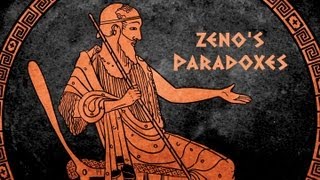(单词翻译:单击)
This is Zeno of Elea, an ancient Greek philosopher famous for inventing a number of paradoxes,
这是埃利亚的芝诺,一个以发现了许多悖论而著名的古希腊哲学家,
arguments that seem logical, but whose conclusion is absurd or contradictory.
悖论是指一些看上去逻辑合理,但是结论却很荒谬或者自相矛盾的论证。
For more than 2,000 years, Zeno's mind-bending riddles
两千多年来,芝诺具有欺骗性的谜题
have inspired mathematicians and philosophers to better understand the nature of infinity.
启发了数学家和哲学家们更好地理解了“无穷”的本质。
One of the best known of Zeno's problems is called the dichotomy paradox,
芝诺最著名的悖论之一叫做两分法悖论,
which means, "the paradox of cutting in two" in ancient Greek.
它在古希腊语中的意思是“分成两份的悖论”。
It goes something like this:
它是这么来的:
After a long day of sitting around, thinking, Zeno decides to walk from his house to the park.
闲坐着思考了一天之后,芝诺决定从他的家走去公园。
The fresh air clears his mind and help him think better.
清新的空气能够使他的大脑更清醒,帮助他更好地思考。
In order to get to the park, he first has to get half way to the park.
为了到达公园,他首先需要走完整段路程的前半段。
This portion of his journey takes some finite amount of time.
这一段路程将花费他一段有限的时间。
Once he gets to the halfway point, he needs to walk half the remaining distance.
当他到达整段路程的中点时,他又需要走完剩下路程的一半。
Again, this takes a finite amount of time.
同样的,这将花费他有限的一段时间。
Once he gets there, he still needs to walk half the distance that's left, which takes another finite amount of time.
当他到达剩下路程的中点时,他还需要走剩下路程的前半段,这又将花费他一段有限的时间。
This happens again and again and again.
这个过程将会一次一次又一次地发生。
You can see that we can keep going like this forever,
你可以发现,我们可以无限地这样推导下去,
dividing whatever distance is left into smaller and smaller pieces, each of which takes some finite time to traverse.
将剩下的不论多少路程分割成越来越短的路程,每一段都将花费他一段有限的时间。
So, how long does it take Zeno to get to the park?
那么,芝诺到达公园要花多长时间?
Well, to find out, you need to add the times of each of the pieces of the journey.
要知道这个答案,你得将每一小段所花的时间加起来。
The problem is, there are infinitely many of these finite-sized pieces. So, shouldn't the total time be infinity?
问题是,有无限多个像这样有限长度的小段。那么,总时间不应该是无穷大吗?
This argument, by the way, is completely general.
顺便说一下,这个论题非常常见。
It says that traveling from any location to any other location should take an infinite amount of time.
它说的是从任何一个地点移动到任何另一个地点,需要花费无穷长的时间。
In other words, it says that all motion is impossible.
换句话说,它的意思是,任何移动都是不可能实现的。

This conclusion is clearly absurd, but where is the flaw in the logic?
这个结论显然很荒谬。但是,逻辑的瑕疵在哪呢?
To resolve the paradox, it helps to turn the story into a math problem.
为了解决这个悖论,把这个故事还原成一个数学问题会有所帮助。
Let's supposed that Zeno's house is one mile from the park and that Zeno walks at one mile per hour.
我们假设芝诺的家离公园有一英里,芝诺走路的速度是每小时一英里。
Common sense tells us that the time for the journey should be one hour.
常识告诉我们,整段路程的时间应该是一小时。
But, let's look at things from Zeno's point of view and divide up the journey into pieces.
但是,让我们从芝诺的角度来看这个问题,把这整段路程分成许多小段。
The first half of the journey takes half an hour, the next part takes quarter of an hour,
最先一半路程花费1/2小时,之后的一段花费1/4小时,
the third part takes an eighth of an hour, and so on.
第三段花费1/8小时,以此类推。
Summing up all these times, we get a series that looks like this.
把这些时间加起来,我们得到一个像这样的数列。
"Now", Zeno might say, "since there are infinitely many of terms on the right side of the equation,
“现在”,芝诺也许会说,“因为等式的右边有无限项,而且每一项都是有限的,
and each individual term is finite, the sum should equal infinity, right?"
那么它们之和应该是无穷大,对吗?”
This is the problem with Zeno's argument. As mathematicians have since realized,
这就是芝诺论证的问题所在。数学家们后来发现,
it is possible to add up infinitely many finite-sized terms and still get a finite answer.
将无限个有限项相加,是有可能依然得到一个有限的数字的。
"How?" you ask. Well, let's think of it this way.
“为什么?”你可能会问。让我们这样想一想。
Let's start with a square that has area of one meter.
让我们从这个正方形开始,它的面积是1个单位。
Now let's chop the square in half, and then chop the remaining half in half, and so on.
现在把这个正方形切成两半,然后再把剩下的一半切成两半,以此类推。
While we're doing this, let's keep track of the areas of the pieces.
当我们这么做的时候,让我们算一下每一部分的面积。
The first slice makes two parts, each with an area of one-half.
第一刀分成了两份,每一份的面积是1/2。
The next slice divides one of those halves in half, and so on.
第二刀将其中的一份切成了两半,以此类推。
But, no matter how many times we slice up the boxes, the total area is still the sum of the areas of all the pieces.
但是,不论我们切多少次,总面积都是所有小份的面积之和。
Now you can see why we choose this particular way of cutting up the square.
现在你可以看出我们为什么要用这样一种方法来切割正方形了。
We've obtained the same infinite series as we had for the time of Zeno's journey.
我们得到了和芝诺的路程一样的无穷项的数列。
As we construct more and more blue pieces, to use the math jargon,
当我们切割出一个又一个蓝色矩形的时候,用数学的行话来说,
as we take the limit as n tends to infinity, the entire square becomes covered with blue.
当n趋近于无限大时,整个正方形将被蓝色覆盖。
But the area of the square is just one unit, and so the infinite sum must equal one.
但是正方形的面积就是一个单位,所以这无限项之和一定等于1。
Going back to Zeno's journey, we can now see how how the paradox is resolved.
再回到芝诺的路程,我们现在就知道悖论怎么解开了。
Not only does the infinite series sum to a finite answer,
不仅仅是无限项之和可以是有限的,
but that finite answer is the same one that common sense tells us is true. Zeno's journey takes one hour.
而且这个有限的结果还跟常识告诉我们的是相等的。芝诺的路程将花费一个小时。


